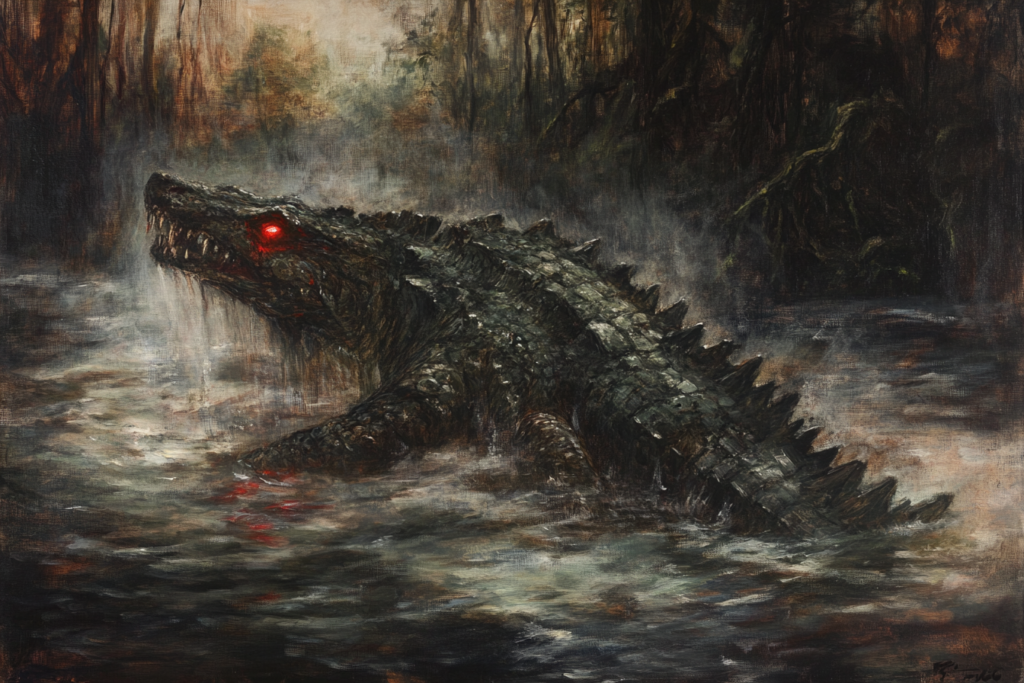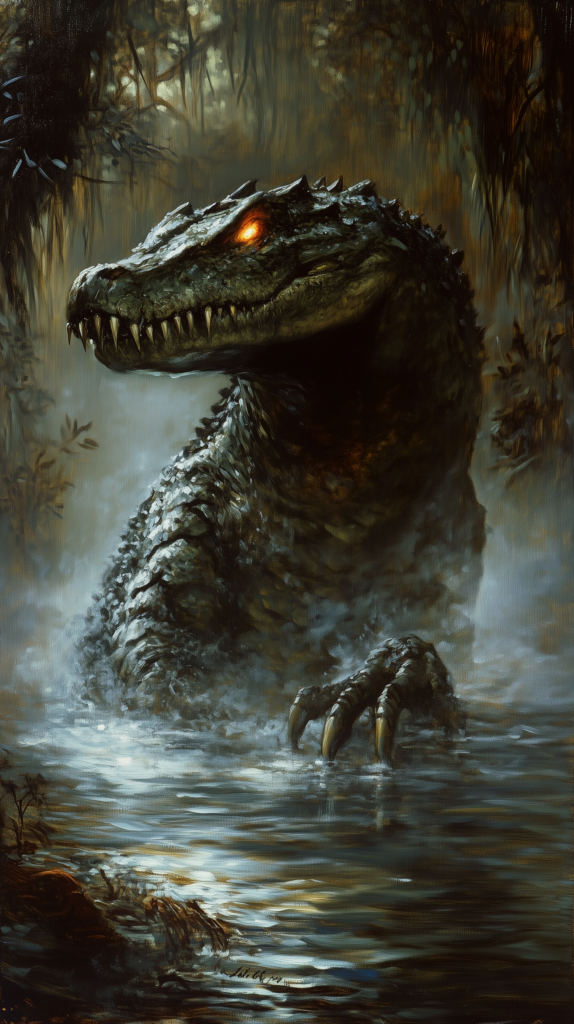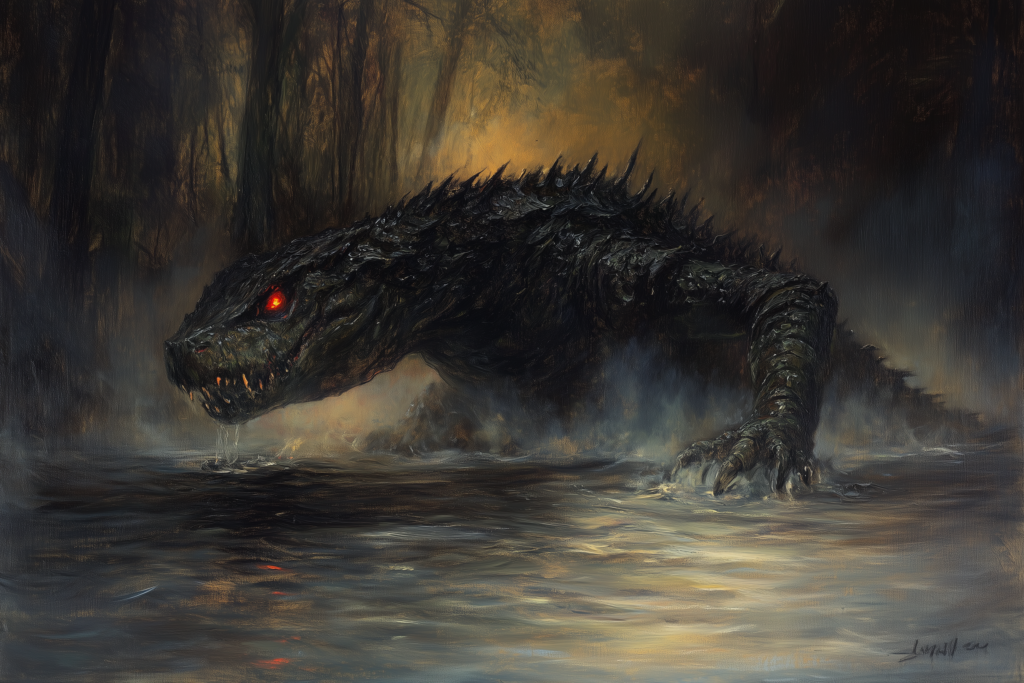Addanc, Beast of the Deep
“Discover the terrifying, dragon-like beast lurking beneath the waters—The Addanc, a legendary monster from Celtic folklore!”

The Addanc is a fearsome creature from Celtic and Welsh folklore, often described as a monstrous, water-dwelling entity with a blend of dragon, serpent, and crocodilian features. It is typically depicted with a sleek, scaly body, elongated and serpentine in form, with powerful claws, sharp teeth, and glowing red eyes. Some legends paint it as having the head of a crocodile or a giant wolf, while others suggest it resembles a massive, malevolent amphibian, its skin dark and slick, covered in sharp spines or armor-like scales.
Behaviourally, the Addanc is territorial, often associated with violent outbursts and predatory tendencies. It is known to terrorize villages near lakes or rivers, emerging from its watery lair when provoked or hungry. In some myths, it is depicted as both intelligent and cunning, capable of laying traps for its prey or manipulating its environment to lure humans or animals into the water.
The Addanc’s habitat is usually remote bodies of water—deep lakes, marshes, or rivers, where it remains hidden beneath the surface for most of the time. Some stories suggest that it lives in a cavernous lair, sunk deep beneath the water, while others speak of it nesting in the murky, inky depths, making it nearly impossible to locate.
Its modus operandi involves a combination of stealth and brute force. The creature often waits until its prey is close, then strikes swiftly, pulling them into the depths with terrifying strength. It can create whirlpools or violent waves to disorient and trap its victims, dragging them under to drown. In some versions of the myth, the Addanc has an almost supernatural ability to cause storms or manipulate water, adding to its fearsome reputation.
The motivation of the Addanc is rooted in survival and dominance. It is driven by a primal need to feed and protect its territory, acting with unyielding aggression when threatened. Some legends hint at a deeper, more sinister motivation, with the Addanc serving as an embodiment of nature’s destructive force or even as a guardian of ancient, hidden treasures beneath the waters. In some interpretations, it is a cursed creature, bound to the waters by an ancient magic, unable to escape its eternal role as a terror of the deep.
Addanc 5e
Addanc Pathfinder
Addanc, the Beast of the Deep

Huge beast, chaotic evil
Armor Class: 18 (Natural Armor)
Hit Points: 346 (28d12 + 168)
Speed: 40 ft., swim 60 ft.
| STR | DEX | CON | INT | WIS | CHA |
|---|---|---|---|---|---|
| 24 (+7) | 14 (+2) | 22 (+6) | 8 (-1) | 16 (+3) | 12 (+1) |
Saving Throws: Dex +8, Con +12, Wis +9
Skills: Perception +9, Stealth +8
Damage Resistances: Bludgeoning, Piercing, and Slashing from nonmagical attacks
Senses: Darkvision 60 ft., passive Perception 19
Languages: Aquan, understands Common but can’t speak
Challenge: 16 (15,000 XP)
TRAITS
- Amphibious. The Addanc can breathe both air and water.
- Legendary Resistance (3/Day). If the Addanc fails a saving throw, it can choose to succeed instead.
- Innate Camouflage. The Addanc can take the Hide action even when lightly obscured by fog, mist, or water.
- Terror of the Deep. Creatures within 30 feet of the Addanc that can see it must succeed on a DC 18 Wisdom saving throw or be frightened for 1 minute. A frightened creature can repeat the saving throw at the end of each of its turns, ending the effect on itself on a success.
- Crushing Swell (Recharge 5–6). As a bonus action, the Addanc causes a massive surge of water around it. All creatures within 20 feet must succeed on a DC 20 Strength saving throw or be knocked prone and pushed 10 feet away.
ACTIONS
- Multiattack. The Addanc makes three attacks: one with its Bite, one with its Tail, and one with its Claws.
- Bite. Melee Weapon Attack: +12 to hit, reach 10 ft., one target.
Hit: 36 (5d10 + 7) piercing damage. - Tail. Melee Weapon Attack: +12 to hit, reach 15 ft., one target.
Hit: 25 (3d10 + 7) bludgeoning damage, and the target must succeed on a DC 20 Strength saving throw or be knocked prone. - Claws. Melee Weapon Attack: +12 to hit, reach 10 ft., one target.
Hit: 21 (3d8 + 7) slashing damage. - Devouring Waters (Recharge 5–6). The Addanc creates a vortex of water around its body. All creatures within 30 feet must succeed on a DC 18 Strength saving throw or be pulled 20 feet toward it and take 27 (6d8) bludgeoning damage. Creatures that succeed take half damage and are not pulled.
- Swallow. Melee Weapon Attack: +12 to hit, reach 5 ft., one Medium or smaller target.
Hit: The target is swallowed and is restrained, blinded, and unable to breathe while inside the Addanc. At the start of each of the Addanc’s turns, the swallowed creature takes 27 (6d6) acid damage. If the Addanc takes 30 damage or more on a single turn from a creature inside it, the Addanc must succeed on a DC 20 Constitution saving throw or regurgitate the creature, which falls prone in a space within 10 feet of it.
LEGENDARY ACTIONS
The Addanc can take 3 legendary actions, choosing from the options below. Only one legendary action can be used at a time, and only at the end of another creature’s turn. The Addanc regains spent legendary actions at the start of its turn.
- Tail Slam (Costs 1 Action). The Addanc makes one Tail attack.
- Bite (Costs 2 Actions). The Addanc makes one Bite attack.
- Surging Tide (Costs 3 Actions). The Addanc causes a surge of water in a 30-foot radius. All creatures in the area must succeed on a DC 18 Dexterity saving throw or take 22 (4d10) bludgeoning damage and be pushed 15 feet away.
TACTICS
The Addanc uses the terrain to its advantage, luring enemies to the water where it can employ Devouring Waters to drag foes closer. It isolates targets with its Terror of the Deep, focusing on frightened or prone creatures with its Bite and Claw attacks. Against groups, it uses Crushing Swell or Surging Tide to disrupt and reposition its enemies, aiming to dominate the battlefield. When heavily wounded, it retreats into deep water, relying on Innate Camouflage to escape and regroup.
Addanc

The Addanc is a lake monster that preys upon any foolish enough to fall into or Swim in its lake.
Hu Gadarn’s oxen dragged the addanc out of the lake; once it was out of the water, it was powerless and could be killed. An alternate story relates that it was rendered helpless by a maiden who let it sleep upon her lap; while it slept, the maiden’s fellow villagers bound the creature in chains. The creature was awakened and made furious; its enraged thrashings crushed the maiden, in whose lap it still laid. It was finally dragged away to the lake Cwm Ffynnon, or killed by Peredur.
Some later British legends ascribe the creature’s death to King Arthur or to Percival. Close to Llyn Barfog in Wales is a hoof-print petrosomatoglyph etched deep into the rock “Carn March Arthur”, or the “Stone of Arthur’s Horse”, which was supposedly made by King Arthur’s mount, Llamrai, when it was hauling the terrible “afanc” monster from the lake.
This monster possesses the form of a crocodile plus the fur of a beaver and the behavior of both.
The addanc is a solitary predator that builds dams to create small lakes. Once its territory is defined, anything that comes near to the lake or adjoining river becomes the addancs prey. The beast hunts by floating just under the surface of the water and waiting for its next meal to approach, at which point it attacks with a bone-crunching bite. With the prey held tight in its jaws, the addanc attempts to drag its quarry under the water.
Both industrious and conniving, this monster possesses enough Intelligence to wait for its prey to be the most vulnerable. Once it attacks, it goes immediately for the kill, giving its prey little chance to resistance. It cares not for its prey; it cares only for itself.
Like the natural beavers lodge, an addancs lair can only be accessed from below the waters surface. The structure is a truly grisly location. As the creature uses the possessions and remains of its victims for decoration, and the stench of decay permeates the entire lair. The adjoining damn is composed of heavy tree branches and logs while long bones of larger prey are interspersed to shore the structure. A typical addanc lair is between thirty and fifty feet in diameter and rises about fifteen feet above the surface of the water.
An addanc is about seven feet long and weighs 250 pounds.
| Addanc CR 7 |
| XP 3,200 NE Large magical beast Init +2; Senses Low-Light Vision, Scent; Perception +14 |
| DEFENSE |
| AC 19, touch 11, flat-footed 17 (+2 Dexterity, +8 natural, -1 size) hp 85 (10d10+30) Fort +12, Ref +9, Will +4 |
| OFFENSE |
| Speed 20 ft., Swim 30 ft. Melee bite +15 (2d6+6 plus Grab), 2 claws +15 (1d6+6), tail slap +12 (1d8+3) Space 10 ft.; Reach 5 ft. (10 ft with bite) Special Attack death roll (2d6+9 plus trip) |
| STATISTICS |
| Strength 22, Dexterity 15, Constitution 16, Intelligence 5, Wisdom 12, Charisma 7 Base Atk +10; CMB +17; CMD 29 (33 vs trip) Feats Great Fortitude, Improved Natural Armor, Improved Natural Attack (bite), Multiattack, Power Attack Skills Perception +14; Racial Modifiers +4 Stealth (in water), +4 Swim SQ hold breath, swimming grapple |
| SPECIAL ABILITIES |
| Death Roll (Ex) When grappling a foe of its size or smaller, a addanc can perform a death roll upon making a successful grapple check. As it clings to its foe, it tucks in its legs and rolls rapidly, twisting and wrenching its victim. The addanc inflicts its bite damage and knocks the creature prone. If successful, the addanc maintains its grapple. Hold Breath (Ex)An addanc may hold its breath for (four times its Constitution score) rounds before beginning to drown.Swimming Grapple (Ex)An addanc can Swim at full Swim speed while grappling a creature. |
| ECOLOGY |
| Environment temperate aquatic Organization solitary or pair Treasure standard |
Section 15: Copyright Notice – Book of Beasts: Monsters of the River Nations
Book of Beasts: Monsters of the River Nations, copyright 2010 Jon Brazer Enterprises; Author Steven Helt.

 Buy me a coffee
Buy me a coffee